There is something wrong with the Dodge Challenger (and Charger) Hellcat. Not the 707 horsepower under their hoods.
There can be nothing wrong with that.
The problem is that everyone knows they have 707 hp under their hoods. Your intentions couldn’t be more obvious. Might as well pull up right beside a cop and do a burnout. And even if you don’t, he knows you are planning to.
This makes it harder to act on those intentions without repercussions.
But almost no one knows there is a Jeep with the same 707 horsepower engine under its hood. Which makes it so much easier to have fun regularly – and without the repercussions.
The Hellcat Challenger and Charger also have another limitation – one which doesn’t afflict the Trackhawk.
Neither of them is a rainy day supercar. They are built for speed on dry, paved roads.
This Jeep, on the other hand… .
WHAT IT IS
A three-seconds-to-sixty Hellcat in didden do nuffins Grand Cherokee drag.
The same 6.2 liter supercharged V8, ultra-performance everything plus all-wheel-drive, eight inches of ground clearance and without the bear-baiting obviousness of what you’re up to.
It stickers for $86,995.
This is substantially more than the Hellcat ($64,295 for the Challenger version). You could even buy the new 840 hp Demon ($83,295) and still pay less. But what you’re paying for here, in addition to the obvious, is what’s not.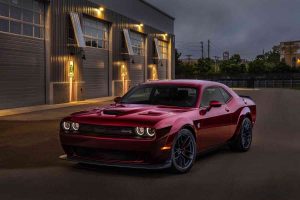
Stealth.
And if that doesn’t sway you, there’s something else which might.
Performance.
Superior perfomance.
The Trackhawk is quicker under certain conditions than the Hellcat and the Demon – and unlike either of them, its ultra-performance capabilities aren’t restricted to dry and paved roads only.
The Trackhawk is the newest home for the Hellcat’s supercharged 6.2 liter V8 . . . plus some other things.
It’s the first time the almost-Nextel-Cup V8 has been paired with the traction advantage of AWD and the off-paved-roads advantage of eight inches of ground clearance.
It’s fast and discreet – and it goes fast almost anywhere. You can launch with less smoke – and there’s less slip.
Which is why the Trackhawk is nearly as quick as the Hellcat (and Demon) on dry pavement, quicker when it’s wet and can tackle roads and conditions neither of them can.
WHAT’S GOOD
A Hellcat without the advertising.
With much more traction.
Can do other things a Hellcat can’t – including tow as much as 7,200 lbs.
Uses less gas than you might think.
Radius of action is limited by how much gas it can carry – which is the same amount of gas as a 295 hp V6 Cherokee carries.
Hard to drive with the herd.
Even though it’s a bargain given what you get, it’s still hard to get unless you can afford the almost six-figure sticker.
UNDER THE HOOD
Maybe you remember the garage scene in the original Mad Max. Over in the corner, the last of the V8 Interceptors – supercharger poking through its hood, making goosebumps-raising gear-whine noises as Max blips the throttle.
Similar situation here – including the blower whine, which they haven’t muted. Blip the Trackhawk’s throttle and you will hear it sing, too.
The main difference here is that the blower is discreetly tucked under the Trackhawk’s just vaguely suspicious-looking hood, with its pair of deeply inset hot-air bleeds dropping hints about what lies beneath.
The air scoop is mounted on the down low – where the fog lights would be if this were a standard-issue Grand Cherokee. It ducts colder, denser air from below and feeds it to a water main-sized 92 mm throttle body up top, which pipes the air to the twin-screw supercharger, where it is compressed (11.6 psi of boost) and then stuffed into the 6.2 V8’s cylinders.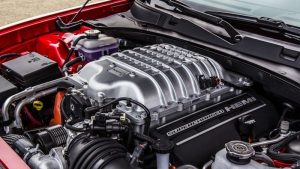
The 6.2 V8’s high-flow heads are aluminum but the block is cast iron – which is heavier but also very hard to hurt. Ditto the forged steel crank, which touts “induction-hardened bearing surfaces so strong it can withstand firing pressures of nearly 1,600 PSI – the equivalent of five family sedans standing on each piston.”
There is also a high-performance intake cooling system designed to keep the temperature of the incoming air charge below 140 degrees – critical to the production of maximum power in a supercharged engine, which generates a lot of heat (picture the twin screws inside the blower rotating at close to 15,000 RPM).
Cast iron headers (too bad you can’t seem them) and Hemi orange paint for the block (which you can see) round out the package.
It all adds up to the mightiest street-legal/production engine V8 on the road – except for the 840 hp version of this V8 that’s available in the Demon, a raise-you-three version of the Challenger that Dodge figured would keep the people who’ve gotten used to the Hellcat entertained.
Uniquely, the Trackhawk combines the 6.2 V8’s might with a high-performance all-wheel-drive system which (in Track mode) sends 70 percent of the engine’s power to the rear wheels and 30 percent to the front wheels. This enables spectacularly hard launches on wet pavement, which is where the Trackhawk has an acceleration advantage over the rear-drive-only Hellcat and Demon.
Even the Demon – its stupendous 840 hp notwithstanding – isn’t much quicker on dry pavement. It takes 2.8 seconds to achieve 60 vs. just over 3 for the Trackhawk. That is enough to lift the Demon’s front wheels off the ground coming off the starting line. But it’s not enough to shake the Trackhawk, which will only be about a car length off the Demon’s bumper at the end of the quarter-mile.
Wetness doesn’t put the kibosh on the fun – and that’s key to understanding the appeal of this thing – and why it’s well worth the extra $20k vs. the Hellcat..
No need to dial things back when it starts to rain. Even if it is pouring rain, you can let loose the full fury of the supercharged V8.
That’s not a good idea in the RWD Hellcat.
Launch control, stability control and traction control can only control so much. Physics controls the rest. It can be fun to go sideways down the road, contrails of tire smoke in your wake.
But a wet road is Kryptonite for the Hellcat – as far as going fast goes. You can still drive it, but not all out. It won’t run to 60 in three seconds in the pouring rain. You had better dial it back until the road dries off.
If you want to be a weather-independent Road Warrior, then the Trackhawk is the perfect Interceptor for you.
That goes for gravel roads, too.
Muddy, rutted, washed-out gravel roads aren’t meant for cars generally – and forget cars like the Hellcat, which have vulnerable chin spoilers, low-hanging mufflers and no all-wheel-drive to claw you up an unpaved 13 percent grade in a downpour.
Easy meat for the Trackhawk – which is after all a Grand Cherokee and so one of the ablest SUVs on the road – or off.
You can also run fast on gravel/rutted/muddy roads.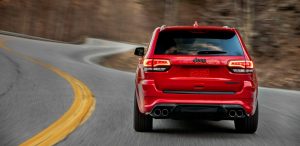
This is an expansion of fun as well as a different kind of fun.
There is a practical element to it as well – and it’s not merely that you can take the off-the-beaten-path.
It is that The Man can’t.
Not if The Man is in a car, at any rate. And if he is in another SUV he won’t be able to keep up with the tracks you’re making. All you need to do is put some distance between you and him – and that’s not hard thing in this thing. Once you’ve done that, the Trackhawk’s other virtue comes to the fore:
It looks like just another Cherokee.
Fade away into the crowd.
Mopar muscle cars were not just known for their speed but also for their look-at-me looks. A Panther Pink ’70 AAR ‘Cuda isn’t going to pass by unnoticed – even if it’s doing less than the posted speed limit.
It’s smarter to be stealthier. That way, you can exceed the speed limit and stand a better chance of passing by unnoticed.
There are a few tells, but – like in Vegas, at the high-roller’s table – it takes an expert to spot them. There is that somewhat un-Cherokee hood, for instance. With its meshed-grille air vents off to either side.
Hmmmm…
Those really big brake calipers. These come powder-coated bright yellow; Jeep ought to offer a “black out” option.
How come there are no fog lights?
There are four exhaust tips. How many is a Cherokee supposed to have?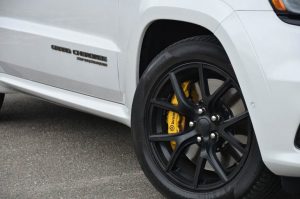
But so many SUVs – and so many cars – have big wheels, powder-coated brake calipers and multiple-tip exhaust.
But none have 707 horses under their hoods.
The Jeep does,but doesn’t make too much of an issue out of it.
The Hellcat, meanwhile . . .
Also, it can’t take your crew on a hell ride. The Jeep can. Five of you. Plus pull a heavy trailer. Anywhere you want to go – as fast as you dare and regardless of the weather.
The obvious tells – other than under the hood – are on the inside. Real carbon fiber on the door panels and dash; not the cheap imitation stuff you find in pretenders. A 200 MPH speedometer – which the Trackhawk can just about peg. The dragstrip Christmas tree button for the Launch Control adjacent to the rotary knob controller for the other modes. Including Sport, Track, Tow and Snow modes, which you can further custom-configure to your liking via the 8.4 inch LCD UConnect touchscreen.
There are also the Hellcat/Trackhawk-specific Performance Pages apps, which include a real-time horsepower and torque dynamometer, lap time/acceleration/G force recorders and LCD gauges for almost any engine/operating parameter you might want to keep an eye on. For the back seaters, dual DVD monitors.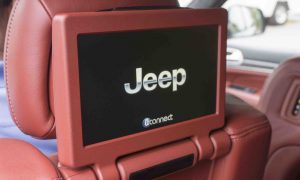
A fantastic 825 watt/19 speaker Harman Kardon audio rig is available, too – but the supercharger sounds so good you’ll probably never listen to it.
You’v also got almost 70 cubic feet of total cargo capacity with the second row seats folded flat – and that’s another thing the Hellcat and the Demon haven’t got.
THE REST
The Trackhawk rates 11 city, 17 highway – which is actually not bad mileage, given what you’ve got. In the ’70s, V8 powered cars got about the same mileage – but had about five times less power.
Now you’ve got power – almost unbelievable power – and the appetite isn’t much worse. Hell, a current Toyota Sienna minivan with a 3.5 liter V6 only rates 18 city, 24 highway – and it does not have 707 hp and doesn’t get to 60 in just over three seconds, either.
The Trackhawk’s not-bad mileage only seems bad because of its relatively small tank. If it had a 30 gallon tank instead of 24.6 gallons (the same as a base V6 Grand Cherokee) it’d have a city range of 330-something miles instead of just over 260. 
The fuel fill, incidentally, is capless. Just pop the door and insert the nozzle. FiatChrysler (which includes Dodge and Jeep) is making that change across the lineup, chiefly to eliminate the problem of people not properly tightening the gas cap and because of that, triggering the “check engine” emissions control light to come on.
Is there anything not to like about this thing? Yeah, one thing.
Not many of us can afford to buy it. That goes for the Hellcat, too.
Sigh.
THE BOTTOM LINE
That old saying about speed being just a question of money is still true, but with an asterisk.
Speed is also a question of stealth.
How much speed do you want to get away with?
. . .
Got a question about cars – or anything else? Click on the “ask Eric” link and send ’em in!
If you like what you’ve found here, please consider supporting EPautos.
We depend on you to keep the wheels turning!
Our donate button is here.
If you prefer not to use PayPal, our mailing address is:
EPautos
721 Hummingbird Lane SE
Copper Hill, VA 24079
PS: EPautos magnets are free to those who send in $20 or more. My latest eBook is also available for your favorite price – free! Click here. If you find it useful, consider contributing a couple of bucks! 


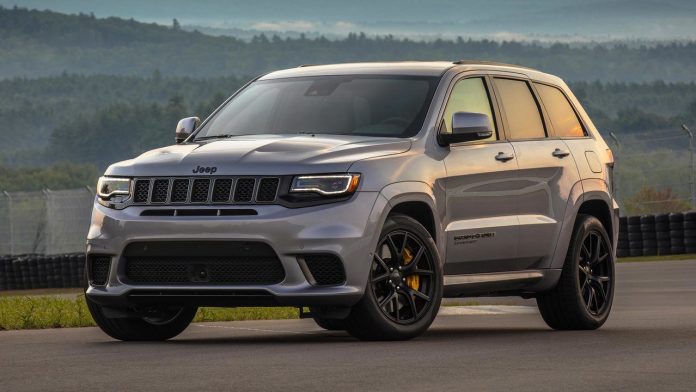



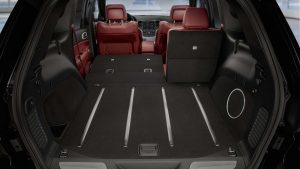
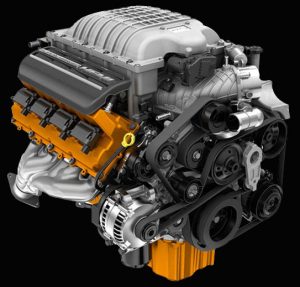
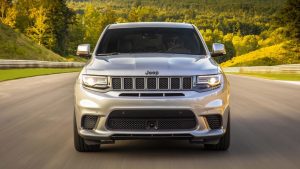
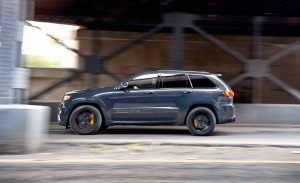
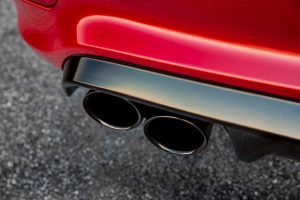








Wonder what the depreciation will do to these in a year or three? Much more affordable fun then, plus probably low miles even if thrashed. Save, wait, scheme and dream, the used $ goes much further.
I can’t believe there are not more comments on this.
Still looking forward to test driving one.
Hey Eric, hope you had a good time with the car. Unfortunately still no word on if / when they launch this in the U.K., but when they do…. I’ll (hopefully) be in line…. if not will just stick to the srt version.
Btw how do you think this thing handles, on a bendy road, relative to an x5? That’s the concern I have owning an American car in the U.K…. roads here are so different to the us, and so much narrower at times….. now really they don’t review cars here properly (as you said in another article) and always focus on shit like the resolution of the screen or the type of plastic… and getting a long test drive will be a bit hard becuse I’ll be buying used, rather than new. Any thoughts ?
i want one but the price is unobtainable new. It cost about 2/3 the price of my house with a total depreciation down 20-30% of the original price. Not to mention repairs. I’ll look into turbo charging a used tahoe with the 6.2 v8.
Moo, I’d never buy one new, I’m thinking of a one year lease, understanding that this is nothing but pure indulgence for a plaything.
I’m just as ambivalent about the new computerized rides as the next man, probably much more so.
But damn, it’s hard to argue with these numbers: take a look, from an article by Eric dated 11 Oct 2011 titled
“Muscle Cars Were Slow”
https://www.ericpetersautos.com/2011/10/11/muscle-cars-were-slow/
* 1970 Dodge Coronet R/T Hemi, 426 CID:
0-60, 6.7 seconds; quarter mile, 13.9 seconds
* 1969 Chevy Camaro Z28, 302 CID:
0-60, 7.4 seconds; quarter mile, 15.2 seconds
* 1970 Buick GSX Stage 1 455 CID:
0-60, 6.4 seconds; quarter-mile, 13.9 seconds
* 1970 Oldsmobile 442 W30 455 CID:
0-60, 6.8 seconds; quarter-mile, 14.2 seconds
* 1970 Pontiac GTO Judge Ram Air III 400 CID:
0-60, 6.6 seconds; quarter-mile, 14.6 seconds.
This all purpose family truckster would absolutely shred any of those top of the line muscle cars from back in the day.
Damn.
I am making an appointment to test drive one.
I will report back.
Not many of us can afford to buy it. That goes for the Hellcat, too.
Sigh. Sigh, Sigh. Sigh, ad infinitum…………….
You’re right. The bodywork is “relatively” stealthy. Hope the exhaust isn’t too loud, because that could blow this concept right out of the water.
And as you mentioned in a previous column, there is a big difference between 4WD compared to this car’s AWD. So “off road” in this context basically means off a paved road. Can’t be taking this puppy too far off of a decently maintained dirt road without running the risk of becoming a pedestrian.
Nevertheless this comes pretty close to my definition of an “everyday” ultra high performance car.
Hi Mike!
Back in ’95, Ford sent me a Cobra R – the last factory 351-powered Mustang. It was a race car with plates; street legal but not a car you’d probably want to drive on the street much. No AC, not even a radio. No back seats. It was about as serious a car as cars got back in ’95.
And that 351 made all of … 300 hp.
This Jeep would slaughter it. And it has AC. And a 19 speaker audio rig.
Phenomenal.